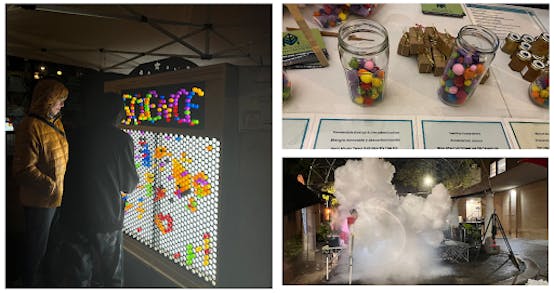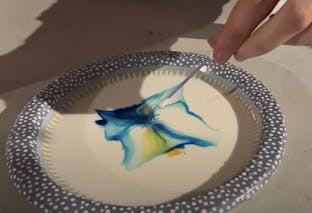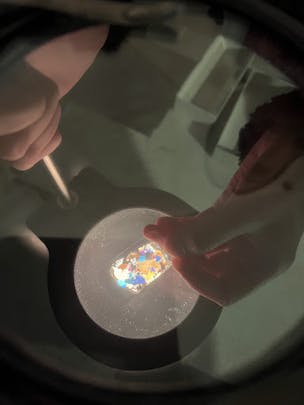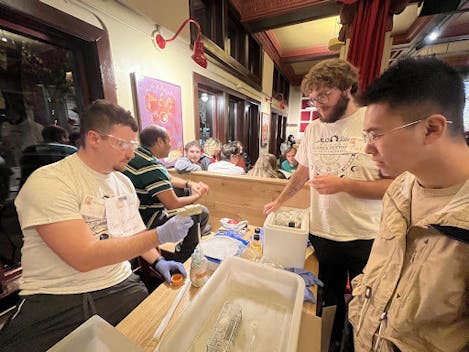The sixth annual Science on the Square festival, hosted by Wisconsin Science Fest, took place on Oct. 19 outside the Wisconsin State Capitol building.
In partnership with the University of Wisconsin-Madison, the Wisconsin Alumni Research Foundation (WARF) and the Morgridge Institute of Research, this was the most anticipated event among the week-long celebration of science and innovation with many opportunities in the greater Madison area to participate.
The festival is marked by a theme each year. This year’s theme was “time” and its influence on science, art and technology. Highlights included once an hour demonstrations by The Wonder of Physics outreach program, the city of Madison Office of Sustainability’s awareness booth and an interactive Science Brite display.

Left: Science Brite station to fuse science and creativity together; Top right: City of Madison Office of Sustainability having citizens rank important sustainable practices they want to see over time in Madison by pom-poms; Bottom right: The Wonder of Physics outreach with Director Haddie McLeand and assistant Sam Kramer (pictured)
The Daily Cardinal spoke with the UW-Madison Biophysical Society, which takes an interdisciplinary approach to science.
Michael O’Connor and Archishman Dakua, UW-Madison students and members of the Biophysical Society, taught others about properties of milk fat and light during the event, including an experiment called “Tie Dye Your Milk.”
“The kids… have a plate of milk. They put some food coloring in it, and then they dip a Q-tip with soap into the food dye and watch it spread out across the milk,” O’Connor said.
This phenomenon happens because soap molecules have one hydrophilic end that is attracted to water, and a hydrophobic end that is repelled by water. The hydrophobic end of the soap molecules stays in the milk, while the hydrophilic end attracts the water-based dye .
”The soap is actually disrupting the surface tension of the milk,” O’Connor said. This happens when the soap molecules wedge themselves between the water molecules at the milk's surface.

Tie Dye Milk experiments representing surface tension
Because the surface tension is broken, Dakua explained, the process “collects all the fats together, and then the water molecules start moving across and then it causes the dye to mix and we see these pretty colors” in the milk.
O’Connor said his favorite part of the festival was “seeing the joy of the children as they watched the tie dye spread apart over the milk.”
O’Connor and Dakua also demonstrated the concept of optical birefringence, or the double refraction of light in a transparent material. To make the transparent material become colored, scientists make use of “differently polarized light,” which are light waves wiggling in different directions up and down or side to side.

Birefringence of crystals
“When differentially polarized light passes through a crystal, due to differences in the refractive indices of the polarized light, they refract differently, and we can see the different colors,” Dakua said.
In this way, the light acts like a secret code, revealing different colors based on how the material is moved. While this concept does not have a direct time component, it is still related to time as differentially polarized light can change with time as the light waves move and interact with different materials. The polarization of light can be constant or can change over time, depending on what it encounters.
Closer to the Capitol, campus biochemistry group The Romero Lab took the theme of time to the molecular level and examined chemical reaction speeds. Their booth, located inside Ian’s Pizza on State Street, explored how baker’s yeast, a common ingredient in pizza dough, contains a special protein known as catalase.
Catalase is a type of enzyme that converts hydrogen peroxide, which is harmful to yeast, into safer molecules like oxygen and water.
“The enzymes in our bodies all want to work at different rates depending on what their functions are,” Mark Mahnke, one of the lab’s PhD students, explained to participants. “but catalase specifically works so fast that it can pretty much eat up any [hydrogen peroxide] molecule that can reach it.”
He said this makes the reaction “diffusion-limited,” meaning the rate of reaction is controlled by how fast molecules move and bump into each other. In yeasts, the molecules involved in the reaction may have trouble finding each other quickly because they are scattered or spread out, so the reaction takes a long time to happen or results in only a small bubbling over.
He then demonstrated how a purified catalase, or catalase isolated from the yeast and concentrated into its own tube, could make the reaction go even quicker with oxygen bubbles shooting out of the tube “like a volcano.” In this case, the reaction was no longer diffusion limited.

The Romero Lab demonstration with the oxygen bubbling over after the chemical reaction occurs
One participant compared the bubbling-over reaction to him burping after eating pizza — which Mahnke said is a similar reaction with different proteins instead of catalase.
The diverse array of booths at the science festival were excited about partnering with the Madison Night Market.
The partnership with the Madison Night Market created “a unique way to explore hands-on science activities while also supporting local businesses and vendors,” the Wisconsin Science Festival website read.
O’Connor, the Biophysical Society member, agreed.
“It's great seeing outreach of the UW-Madison programs interacting with the community and it's a great way to merge the two events,” he said.
Interested in attending this event in the future? The 2024 Wisconsin Science Festival will be hosted October 7-13, 2024. See this website for more information!






